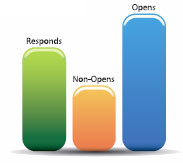A compelling
email marketing campaign can be expected to bear positive effects on many aspects of your nutrition and diet business. Currently, a minority of Americans claim that they are at their best target weight, yet your prospects may not be aware of the range of products and services nutrition and diet business can provide to assist them in their weight loss goals. They may be aware of the existence of your location by passing by your building's signs as they drive by, but they may not know you are offering precisely the type of nutritional product or service they need. To enable your campaign to fulfill the requirements of potential prospects, nutrition and diet business owners and marketers need to consider the following factors.
Implementation
Email marketing for nutrition and diet businesses differs from conventional avenues of advertising like newspapers, magazines, radio, television and Yellow Page listings. One of the most notable differences is the legal criterion, which is more severe and regulated than for older media forms.

Compliance
It is a common practice among nutrition and diet business owners and managers to collect business cards and data about their prospects through counter signup sheets, entry forms or at fairs and expos. However, before entering a client's personal information into your database, US law requires clear and traceable permission on behalf of the customer to be logged within your records.
CAN-SPAM Violations Have Severe Consequences
The
CAN-SPAM Act in the United States regulates email marketing and specifies how companies must handle their email prospects. CAN-SPAM is known as an "opt-out" legislation and requires all email marketers to comply with any subscriber's request to be taken off the list irrevocably and immediately after their first request. Failure to comply with this legislation opens up nutrition and diet businesses to severe legal penalties, including fines and even incarceration.

Facilitate Unsubscribing
United States federal law specifies email marketing campaign missives must provide subscribers with a quick and simple channel to be removed from your list. Every single one of your email newsletter messages must contain a visible and effective unsubscribe link. Failing to act upon a request from a subscriber to be dropped violates the CAN-SPAM Act.
Control Bouncing Emails
When you send out an email, three things can occur:

Success: The email is delivered as intended.
Soft Bounce: The email was delayed due to a problem outside of the sender's control, such as network bottlenecks or your recipient's inbox being full. The email client can no longer accept incoming mail until older emails are deleted.
Hard Bounce: The email cannot be delivered since the email address is nonexistent or has been blocked.
In both bouncing cases, you will receive an emailed message from the online facility known as the Mailer Daemon to inform you of the reasons for the bounce email. A soft bounce is outside your control, but you should nevertheless take steps to rectify it by contacting your customer through other means. If the bounce is hard, then it is your responsibility to stop sending emails to that account. By sending repeat emails to a "hard bounce" address, you ensure that ISPs will place you on a spammer's blacklist, making it impossible to send out any emails at all, personal or professional.
Privacy Policy
Copying a competitor's privacy policy and entering it on your own site creates legal liability as well as duplicate content detrimental to the high search engine rankings you seek. It can also open your business up to legal liabilities. Your business lawyer should draft a complete and thoroughly customized privacy policy designed to fit the exact activities you perform online.
Segment Your Subscription List

Segmentation, or
targeted email marketing, is a critical factor in email campaign success and the primary procedure recommended by industry experts to focus your marketing strategies on the demographics, geographic information and behaviors of your customers. The main reason segmentation is such an important process is that the customers of your nutrition and diet business vary significantly. Some may be obese individuals facing diabetes and other severe health issues; others may be fit but seeking specific nutritional information for a dietary program.
Religious orientation can factor heavily into segmenting your diet and nutrition subscriber base. It would be an error of to promote the nutritional value of pork to your Muslim or Jewish customers, as it would be to feature beef recipes for your Hindu clients. By applying segmentation analysis to your email subscription list, you can produce newsletter content befitting the characteristics of your customers and provide each geographic, personal, income, demographic or behavior category with the information that will motivate them most.

Test Your Email Content
Experienced email marketers are well aware of the need to conduct ongoing testing of their email marketing content. One of the most common tests is called an A/B split test and involves identical newsletters being sent to a segment of the subscription list with just a single element changed, such as the preheader, an image, the
subject line or the position of a link. By comparing how these two different newsletters perform, you can gain valuable insight into what your nutrition and diet business customers are responding to and continue to refine your content through further testing.
Obtaining Personal Data from Your Customer
Most people are hesitant to provide personal information to a subscription list profile, but client privacy requirements and preferences must be balanced against a business need for extensive demographic data to improve segmentation efforts. Offering incentives such as specific discounts and offers or vouchers for nutritional classes to your customers in exchange for basic demographic information such as age, gender and some consumer preferences could serve to assist you in obtaining this critical segmentation data.

Analyze Your Customers' Behaviors
Open and click-through rates are the most critical and important indicators of subscriber behavior. Some subscribers do not open your emails at all; continuing to send missives to these email addresses is unnecessary. Prune these names from your subscription list. Other individuals may open and read your emails but almost invariably fail to follow up with a click-through. These customers should be kept on your email list: they are reading your newsletters , and that could lead to future engagement with your nutrition and diet business. Clients who both read and click through to your website are the most desirable prospects from an
online marketing strategy standpoint, and should be valued above other subscribers. Your promotional efforts should be directed towards providing this group with the highest level of service rewards and special attention.
Best Email Practice
Your email marketing newsletter campaigns must adhere to
best email practices in order to maintain the maximum efficiency, minimize customer complaints and bear a positive overall result on your bottom line. Subject lines, From lines and preheaders should be meticulously crafted; differing mobile and PC browser display abilities must be accommodated in your email template; and you must provide a number of varying landing pages precisely targeting content that synchronizes with your segmentation and A/B split testing efforts.
Email Metrics
The statistics at the core of this guide show that almost two thirds of all nutrition and diet business owners and managers are not aware their click-through rate, and nearly half could not quote their open rate. These key
email metrics form the critical performance basis of any online marketing campaign, and must be understood to gain a clear perspective on how the email campaign is progressing and how it can be optimized for the future.